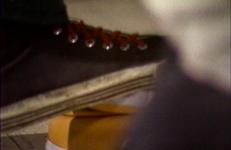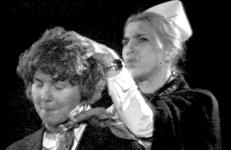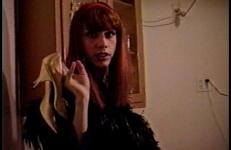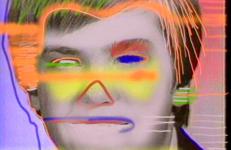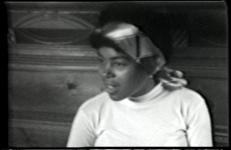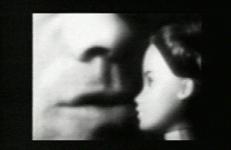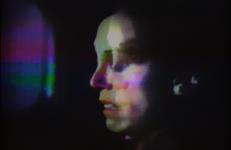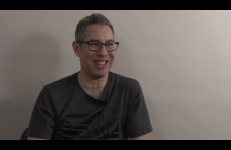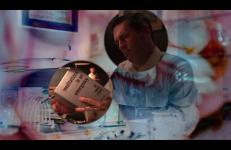2 Channel Land is a north-western docu-fiction film exploring the history of analogue signals spilling across the borders of Ireland and Britain. Guided by a mysterious threshold deity, we take a journey through Ireland's borderlands in search of community.
Television
Joan Logue cuts down considerably Andy Warhol’s projection of fifteen minutes of fame, with this compilation of 30-Second Spots. Produced to be broadcast as individual, mini-documentaries on the included artists and their work, Logue’s short interpretive video pieces feature a prime time selection of over twenty New York performance artists, composers, dancers and writers, including Maryanne Amacher, Robert Ashley, David Behrman, John Cage, Lucinda Childs, Douglas Ewart, Simone Forti, Jon Gibson, Philip Glass, Spalding Gray, Joan Jonas, Bill T.
In A Case for the Closet, Glennda Orgasm and Judy LaBruce host an episode of Closet Talk. They discuss why they are for people staying in the closet, and attribute coming out of the closet to the mediocrity, and thus downfall, of gay culture. Glennda and Judy establish their new movement, XXX Gay (replacing the postqueer movement), and explain its philosphies and values.
A Pilot For A Show About Nowhere is a two-channel video that examines the politics of television viewership, incorporating footage from a number of sources to create a plurivocal narrative.
Anthony Ramos' astute deconstruction of television news focuses on his part in the media coverage of President Jimmy Carter's 1977 declaration of amnesty for Vietnam draft evaders. Ramos, who had served an 18-month prison sentence for draft evasion, was interviewed by news reporter Gabe Pressman, whose film crew meets Ramos' video crew in a confrontation between technologies and sensibilities. At the time, some broadcast television news crews still used 16mm film, although the expensive transition to ENG (electronic news gathering) systems had begun in 1974.
A son discreetly records fleeting moments in his parents’ suburban home. An intimate portrait of a stable life lived according to the rules of society.
McGuire constructs a murky black and white soap-opera world of endless, timeless, and placeless limbo, where the characters talk to each other entirely in clichés, bad poetry, and other contrite forms of speech — a short TV show in which nothing is resolved. The video culminates in an absolutely stunning monologue performance by legendary underground film and videomaker George Kuchar.
“All that is solid melts into air, all that is holy is profaned, and man is at last compelled to face with sober senses his real conditions of life, and his relations with his kind.”
— Karl Marx and Friedrich Engels, The Communist Manifesto, 1848
A captivating video about surveillance, identity, watching, and being watched, The Amateurist slides along the edges of horror and satire to create an unsettling portrait of a woman on the brink of a technologically driven madness.
"The Amateurist has very few precedents--many films provoke laughter and tears, but few (only Chantal Akerman's early work and Todd Haynes Safe spring to mind) do so in a way that taps so directly into submerged contemporary anxiety."
In the video An Evening with Kembra, Glennda and Brenda attend one of Kembra Pfahler's dinner shows on New York City's Lower East Side. At her show, she performs cabaret versions of songs from her band The Volumptuous Horror of Karen Black. After the show, the group discusses the relationship of her work to queer culture. Interspersed throughout the video are two short clips: a skit entitled Drag Queen Starter Kit, and a call to boycott a bakery due to its discriminatory behavior.
“The syntactic structure and lateral movement of Arcade match its fairground equivalent. The work includes a series of images recycled from television and film, interspersed with location footage of Chicago El stations and punctuated with paintings created by Paschke on a computerized paint box. Flashing insights and lights, the ready-made imagery presents a sideshow of current concerns playing on the slippage between the televised and the real.”
“The syntactic structure and lateral movement of Arcade match its fairground equivalent. The work includes a series of images recycled from television and film, interspersed with location footage of Chicago El stations and punctuated with paintings created by Paschke on a computerized paint box. Flashing insights and lights, the ready-made imagery presents a sideshow of current concerns playing on the slippage between the televised and the real.”
In October 1969, the Videofreex visited the home of wealthy political and social activist, Lucy Montgomery, as she was hosting the Black Panther Party of Chicago during one of their most fraught times – the period just after Chairman Bobby Seale was wrongfully imprisoned for inciting riots at the Democratic National Convention a year earlier. This video documents an interview with the wife of Bobby Seale, Artie Seale.
In the fall of 1974 Doug Hall and Jody Procter began to develop a presidential archetype, which they called "the Artist-President." Procter wrote the speeches that Hall delivered "presidentially" in performances. Over time, the character became more explicitIy based on JFK, requiring a makeup artist and a speaking style more recognizably Kennedy-esque. On November 22, 1975, members of T. R. Uthco (at the Anthology Film Archives in New York) and Ant Farm (at a church in San Francisco) simultaneously screened media from their reenactment of President Kennedy's assassination.
In the fall of 1974 Doug Hall and Jody Procter began to develop a presidential archetype, which they called "the Artist-President." Procter wrote the speeches that Hall delivered "presidentially" in performances. Over time, the character became more explicitIy based on JFK, requiring a makeup artist and a speaking style more recognizably Kennedy-esque. On November 22, 1975, members of T. R. Uthco (at the Anthology Film Archives in New York) and Ant Farm (at a church in San Francisco) simultaneously screened media from their reenactment of President Kennedy's assassination.
Asian Studs Nightmare examines the racial politics behind the hit U.S. television show STUDS. Fulbeck frantically recalls somewhat fictional nightmares of Asian male identity. Over a multi-layered visual of the actual STUDS show and Asian male stereotypes, Asian Studs reveals the pervasive racial hierarchies and taboos depicted in mass media and probes their relation to interracial dating patterns and minority status in the United States.
In Bad Grrrls, Glennda and Fonda LaBruce attend a Riot Grrrl conference on New York’s Lower East Side. At the conference, they conduct interviews with punk women, performers and artists, including Penny Arcade and Sadie Benning. In doing so, Glennda and Fonda navigate a range of perspectives on feminism, punk, and underground activism. Furthermore, they engage with questions of drag’s relationship with feminism, and how one would reconcile the problems of punk with Riot Grrrl’s desire for women’s liberation.
Gibbons plays the sleazy Director and lampoons the movie audition and its legendary corollary, the casting couch. Barbie is recast, not as the impossible-to-attain ideal beauty, but as the victim of sexual harrassment and exploitation.
This title is also available on Joe Gibbons Videoworks: Volume 1.
In this angry answer to the expectations advertising culture places on women and their bodies, Tanaka deftly edits commercial images and sound-bite slogans to underscore the message such images carry: that women exist to please men, as wives, mothers, and lovers. Tanaka balances such mainstream images with black and white footage of herself lying naked next to her own doubled image, rejecting the mainstream model of female sexuality that regularly consists of seductive glances and suggestive poses arranged and pre-ordained for the male gaze of the spectator.
Glenn Belverio is an independent filmmaker and drag artist who lives and works in New York City. In 1990, he began producing and co-hosting the popular Manhattan Cable series The Brenda and Glennda Show, a talk show that mixed activism with comedy as it took drag out of the clubs and onto the street. In 1993, the show became Glennda and Friends, a post-queer task show featuring provocative co-starts such as gay pornographer Bruce LaBruce and guerrilla scholar Camille Paglia.
This video is part of the 5 Video Hits series.
This piece still seems relevant to me somehow, perhaps because its main characters remain titans in the entertainment industry. But what of Janet Jackson, off-screen then and now?
An architect and urban planner by training, Dara Birnbaum began using video in 1978 while teaching at the Nova Scotia College of Art and Design, where she worked with Dan Graham. Recognized as one of the first video artists to employ the appropriation of television images as a subversive strategy, Birnbaum recontextualizes pop cultural icons (Technology/Transformation: Wonder Woman, 1978-79) and TV genres (Kiss the Girls: Make them Cry, 1979) to reveal their subtexts.
"Black Holes/Heavenly Bodies-Hell is a high-tech nightmare about a coming-of-age in America in which violence and mediocrity are the potent background noise." – Steve Seid
Book Report explores themes of sexual assault, the weaponization of language, and the futility of escape. It combines short sequences of Mad Men's Don Draper with relevant facts about the 2016 presidential campaign — including a history of the hashtag #trumpbookreport and notes on a payment to the mysteriously named “Draper Sterling” ad agency. A choral voice-over, drawn from the infamous Access Hollywood transcript, revises the misogynist “locker room talk,” turning it against the original speaker.





